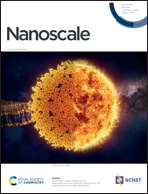Evidence of oxygen vacancy-mediated ultrahigh SERS sensitivity of Niobium pentoxide nanoparticles through defect engineering: theoretical and experimental studies†
Abstract
Oxygen vacancy engineering in metal oxide-based semiconductors has emerged as an important area of research for sensing applications, such as Surface-enhanced Raman scattering (SERS), gas sensing, etc. It has the potential to replace high-cost and unstable noble metal-based substrates in the near future. However, improving the SERS enhancement factor in semiconductor-based substrates remains a challenge. In the present study, we demonstrate that oxygen vacancy engineering in Niobium pentoxide (Nb2O5) enables ultrahigh SERS sensitivity. Oxygen vacancies were induced and manipulated in the Nb2O5 nanoparticles via a facile high-energy ball milling method and post-growth oxygen annealing. A high enhancement factor (EF) of 5.15 × 107 was obtained for the Methylene Blue (MeB) molecule on the oxygen-deficient substrate with the lowest detection limit of 10−8 M, which is 2 orders of magnitude lower than the pristine substrate. Through a careful analysis of the experimental data and theoretical calculations, we investigated the underlying mechanism behind the high EF in SERS and showed that the SERS performance is directly proportional to the oxygen vacancy concentration in the Nb2O5 nanoparticles. Density functional theory (DFT) calculation suggests a strong coupling of the vibronic states and an increased charge transfer (CT) efficiency in the Nb2O5–MeB complex mediated through the vacancy-induced trap states in the defective Nb2O5 structure. Finite element method (FEM)-based simulations revealed a field enhancement factor of ∼4.17 × 102 that contributed to the SERS EF, while the remaining is contributed to the oxygen vacancy-mediated charge transfer, i.e., a factor of ∼1.23 × 105 is due to the high CT efficiency, the highest among the reported values. We believe that these findings offer valuable insights into the fabrication of defect-tailored cost-effective semiconductor-based SERS substrates for ensuing applications, such as trace dye detection.



 Please wait while we load your content...
Please wait while we load your content...